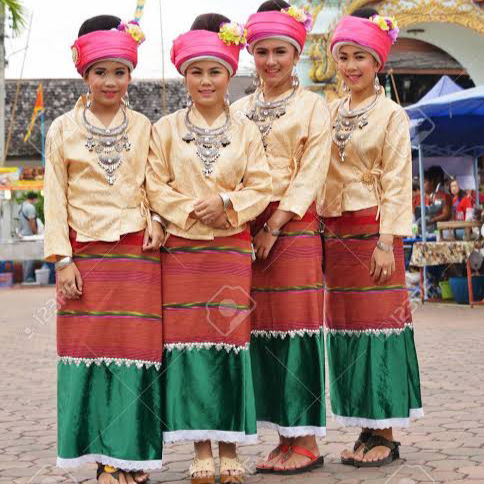Tai Lue

Identification. The Tai Lue are the Tai-speaking inhabitants of Sipsongpanna. (This name is written "Xishuangbanna" in Pinyin; when the status of the prefecture as part of the People's Republic of China is being referred to here it will be written in its Pinyin form, and when the Tai sociopolitical unit is the important issue it will be written in romanized Tai. It should also be mentioned that "Dai" is the Pinyin form of "Tai," which is the conventional spelling in English. There is no difference in pronunciation.) Sipsongpanna means "the twelve thousand fields" or "the twelve principalities." The extent of the kingdom varied over time, but in the precolonial period it included Muang Sing, now in Laos, and parts of the Tai-speaking areas of Myanmar (Burma). Today, however, there are Lue communities throughout northern Thailand, and it is not easy to make distinctions between the Lue and the Yorng and Khoen of Myanmar. There is now also a sizable Lue population in Taiwan. The term "Tai" is used for all Tai-speaking peoples. In the southwestern part of Yunnan these are mainly the Lue and the people known variously as Tai Nuea (Northern Tai), Chinese Shans, Tai Khorn, and Tai Mao. There is considerable difference between the Tai Lue and Tai Nuea languages and they should be considered mutually unintelligible.
Location. Xishuangbanna Dai Autonomous Prefecture lies in the southernmost part of Yunnan Province of the People's Republic of China (PRC), roughly between 21°10′ and 23°40′ N and 99° 55′ and 101°59′ E. The capital of the prefecture is the city of Jing Hong (Ceng Hung, "the city of the dawn"). Jing Hong is situated on the Lancang Jiang, the Mekong River. The Tai Lue mostly live in the river valleys. As in upper Myanmar and north Thailand, the year is divided into three seasons with the rains falling from about June to October.
Demography. In 1923 the population of Tai Lue in Xishuangbanna was estimated at just under 100,000. Recent estimates indicate a figure of 240,000. There have also been major changes in relative populations. In 1923 it was estimated that the Tai Lue constituted slightly over 70 percent of the population of Xishuangbanna. In 1945 this had probably fallen to about 50 percent. During the Korean War, when there was an embargo on the sale of rubber to China, Xishuangbanna proved to be one of the more suitable areas for its growth and there was a massive movement of Han into the prefecture, which reduced the percentage of Tai Lue to about 35 percent. The Lue population of Thailand was estimated at about 50,000 in the 1960s.
Linguistic Affiliation. Tai Lue belongs to the Southwestern Group of Tai languages and is very similar to the languages known as Yorng, Khoen, and Kam Muang (the language of northern Thailand). The writing systems, which are also similar, are derived from the Mon and look like the Burmese script. In the 1950s the PRC reformed Tai scripts in Yunnan, and for Lue additional tone markers were added and all characters were written on the line. These reforms have created some problems. There are complaints that there is not sufficient material to read in the new script and that those educated in the new script cannot read the old Tai Lue documents. One of the major differences between the phonology of Tai Lue and Kam Muang of northern Thailand is that Lue appears not to use diphthongs. In vocabulary, the massive borrowing of Central Thai into Kam Muang has not taken place in Lue; instead, there has been extensive recent borrowing from Chinese.
Bibliography
Chen Han-Seng (1949). Frontier Land Systems in Southernmost China. New York: Institute of Pacific Relations.
Lemoine, Jacques (1987). "The Tai Lue Historical Relation with China and the Shaping of the Sipsong Panna Political System." Proceedings of the International Conference on Thai Studies 3, pt. 1:121-134. Compiled by Ann Buller. Canberra: Australian National University, Department of Anthropology.
Moerman, Michael (1965). "Ethnic Identity in a Complex Civilization: Who Are the Lue?" American Anthropologist 67:1215-1230.
Moerman, Michael (1968). Agricultural Change and Peasant Choice in a Thai Village, Berkeley and Los Angeles: University of California Press.
Thai-Yunnan Project Newsletter (1988). Canberra: Australian National University, Department of Anthropology (numerous items).
